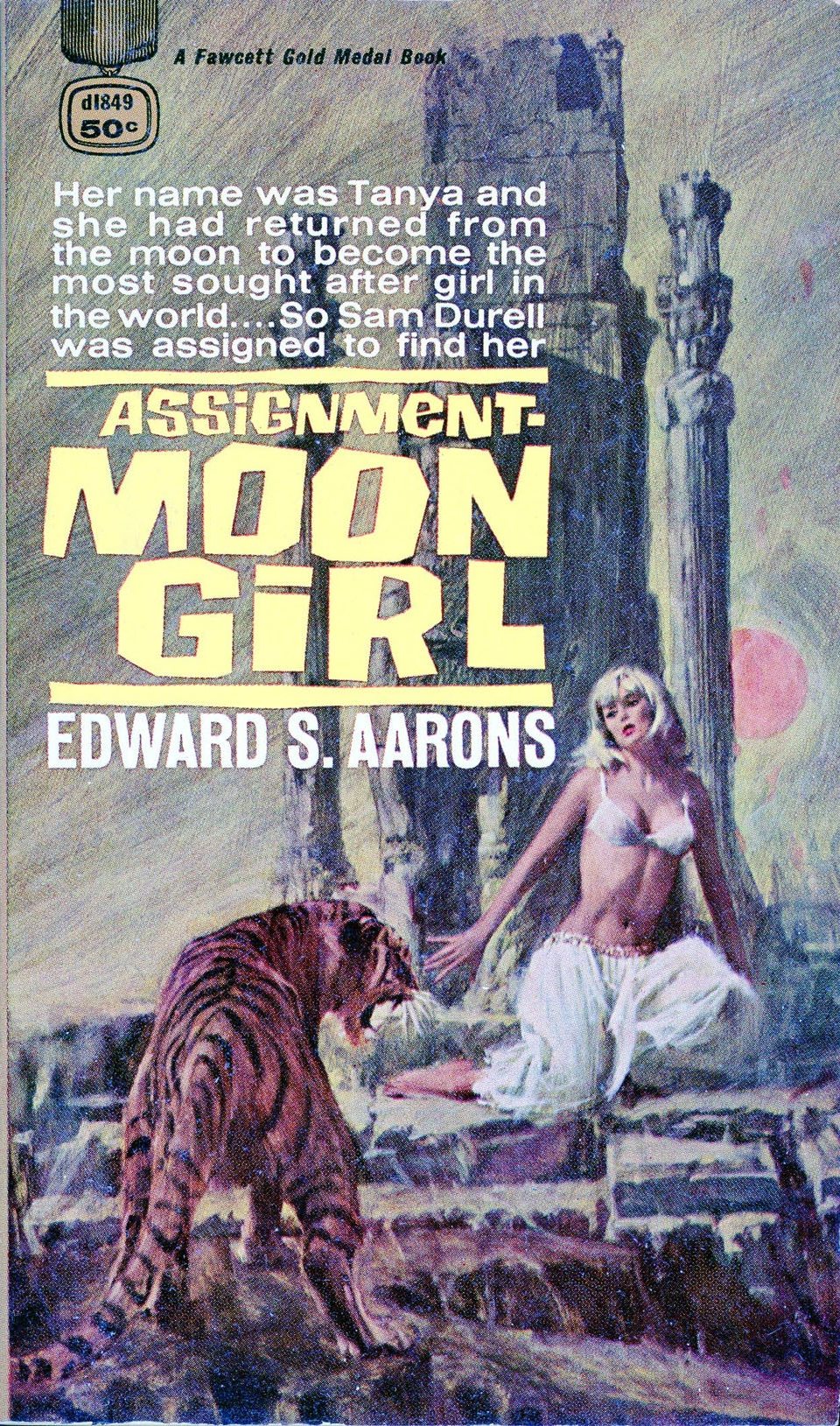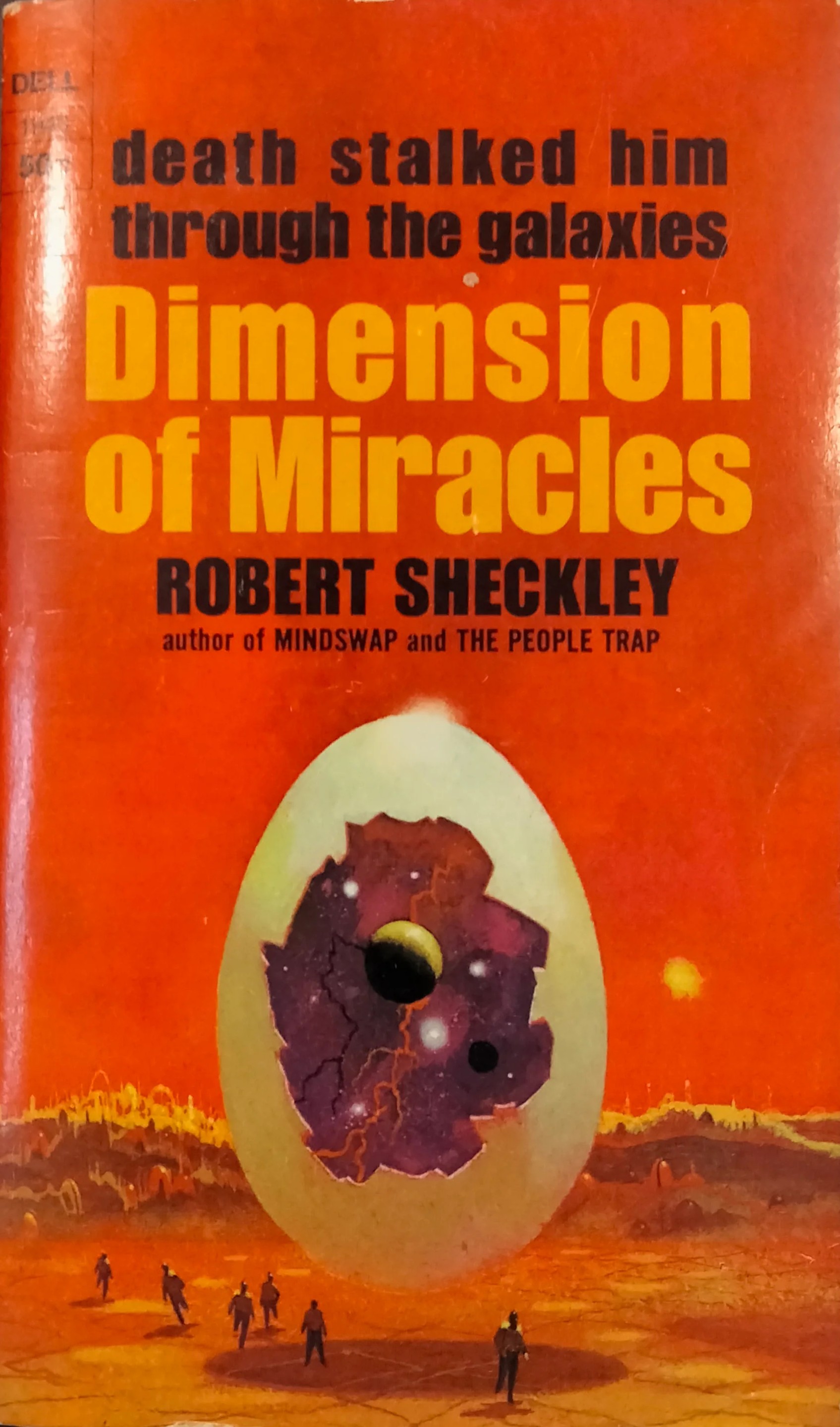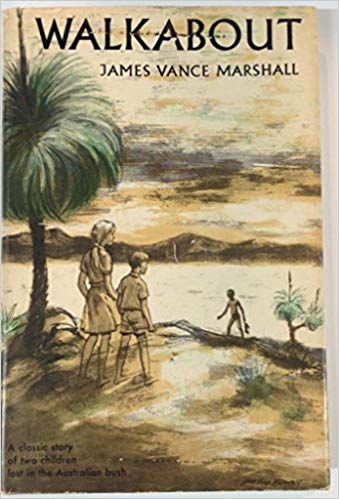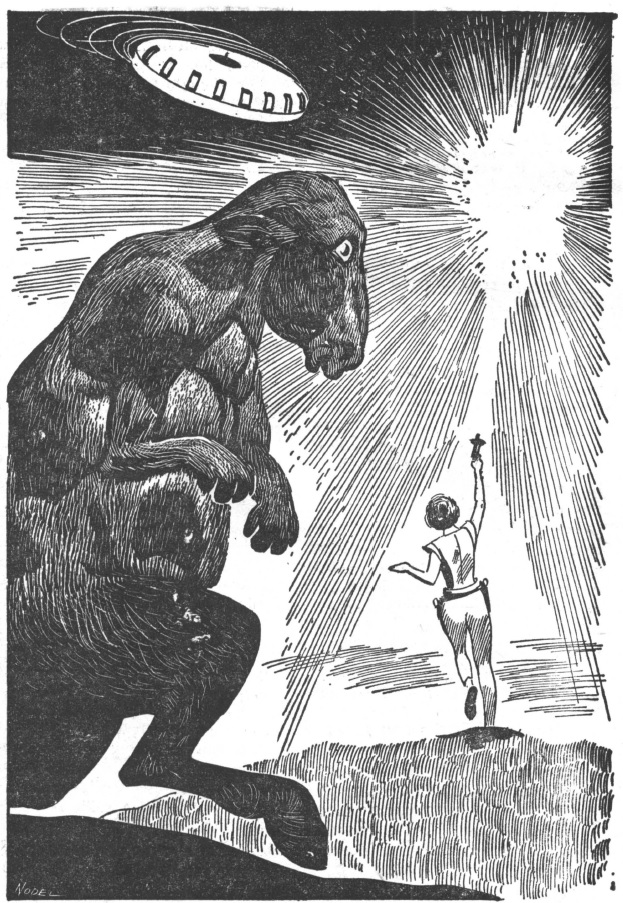
by Mx. Kris Vyas-Myall
In Watermelon Sugar by Richard Brautigan

I occasionally like to check out the authors I hear are very hip right now. It meant I read the excellent Last Exit to Brooklyn and the less great Been Down So Long It Looks Like Up To Me.
Richard Brautigan is one I have heard praise heaped on over Trout Fishing in America but the title put me off (my father talks enough about it!) When I heard he had a more fantastical novel coming out this year I made sure to get a copy.
I am not sure what I was expecting but this book is weird!
It is set in a world that appears to have emerged after some kind of great disaster destroyed the prior civilisation. The people live around iDEATH where the main material for production is “watermelon sugar”. As well as apparently being very versatile in and of itself, the day of the week the watermelons are planted on dictates the type that grow and the different properties they will have.
People used to be hunted and eaten by “Tigers” (it is unclear if these are felines raised up to consciousness or humans that have descended to cannibalism) a fact people of iDEATH seemed to have accepted as a natural part of life. However, these have all been hunted now and what remains are statues to the fallen.
In addition, the narrator lacks a regular name and instead:
Just call me whatever is in your mind. If you are thinking about something that happened a long time ago, somebody asked you a question and you did not know the answer, that is my name. Perhaps it was raining very hard, that is my name. Or somebody wanted you to do something, you did it and they told you what you did is wrong, sorry for the mistake, and you had to do something else, that is my name.
Thankfully this fellow (who I will call Idle Thought) is the only one without a regular name.
Idle Thought is writing the first book in 35 years (the one we are reading) which starts off just recording little notes about his life or small events, similar to The Pillow Book by Sei Shônagon. This is disrupted by InBOIL who declares that he knows the truth of iDEATH and departs to live in the forgotten works, the large remnants of the past world.
Margaret begins to go to the forgotten works to forage for her collection and talks with InBOIL about his finds. A few weeks later, InBOIL and his gang return to show everyone the true meaning of iDEATH.
What does this all add up to? Honestly I am unsure. This is no “polytropic paramyth”, it has all the features of a regular short novel and Brautigan has a great narrative voice. You do not doubt that a land could exist where people have discovered how to spin fruit sugar of watermelons into a wide range of products.
The question is how literally are we meant to take the text? Is this meant to be a far future story where the new technology is beyond our understanding? A far-fetched satire of our current society? A fable about the nature of power and belief? Or something else? Are we even meant to consider Idle Thought a reliable narrator?
I don’t have any answers and can’t help but feel nonplussed by the ending. As a case of literary experimentation, it works better than many authors that attempt similar things (just check out some issues of New Worlds) but I am not sure about how to grade it as SF.
However, it is an experience I would recommend others try for themselves; I will give it four stars.
When Women Rule

by Victoria Silverwolf
Apologies to science fiction historian Sam Moskowitz for stealing the title of his essay, which appeared in the August issue of If last year.

No doubt Mister Moskowitz will add the novel I'm about to review to his list of future worlds dominated by females. Is it a worthy example? Let's find out.
Five to Twelve, by Edmund Cooper

Cover photograph by Reg Perkes.
We jump right into things with our protagonist, a fellow named Dion Quern, sneaking into a luxury apartment with burglary in mind. The place happens to be occupied by a female peace officer named Juno Locke aiming a laser pistol at him.
Futuristic crime novel? Well, not really.
After this opening scene, the author goes into full expository mode. It seems that birth control pills not only freed women from unwanted pregnancy, but it made them bigger, stronger, and smarter. (There's an implication here that, until this happened, they weren't as smart as men. I'll ignore that for now.)
Besides that, it also resulted in fewer boys being born and more girls being born. Now, in the late twenty-first century, men are outnumbered by women (you guessed it) five to twelve.
About three-quarters of women are powerful figures known as Doms. The rest, who have remained feminine (sic) are pretty much just baby machines, impregnated multiple times by artificial insemination. The Doms hire them to bear their adopted children.
Men who are fortunate to be partnered with Doms are known as Squires. Those who aren't are called Sports.
Dion is a Sport, making a living through petty crime and writing poetry on the side. He hates this woman-ruled world; however, as we'll see, he's a very mixed-up and contradictory character.
We last left him facing a cop with a pistol. Does she send him to jail? (Actually, a sort of mind-erasing facility.) Nope. She invites him to share a meal and then to bed.
There's an odd kind of love/hate relationship between these two throughout the book. Dion willingly becomes Juno's Squire. Sometimes they're passionate about each other, sometimes they're ready to kill each other.
Dion gets involved, more or less against his will (as I said, he's a very ambiguous character), in a plot to assassinate Queen Victoria II, as a symbolic act by rebellious men. Let's just say that it all leads up to a bittersweet ending for what has been, up to that point, a satiric novel.
The author's style is quirky. Everybody speaks in a weirdly affected way, full of puns and literary allusions. (The sole exception is one of the women who serve as baby machines, who plays an important part in the last part of the book.)
The big question, of course, is how sexist is it? Quite a bit, I'd say. There's a fair amount of complaining about the fact that this future world has lost its spirit of daring and adventure. (Of course, it has also eliminated war and poverty.) The baby machine is a nearly mindless character, interested only in love, sex, and reproduction, and the author seems to approve of her.
On the other hand, Dion is pretty much a jerk, even if we're supposed to sympathize with him at the end. Maybe the author is more of a misanthrope than a misogynist.
Not a great book. Two stars. Go see a movie instead.

Maybe not this one. It's pretty bad.

by Gideon Marcus
Assignment: Moon Girl, by Edward S. Aarons

I wasn't sure what to expect from this one. Well, that's not quite true. I had expected a silly story, maybe with lots of lurid bits. Instead I got…
Trapped in a pit, menaced by a tiger, cosmonaut Tanya Ouspanaya is nude and defenseless. She knows not why she is there–only that she has somehow returned from the moon, where she had been for days if not weeks. When escape seems impossible, and on the verge of losing all hope, a strange man speaking bad Russian arrives to rescue her.
Meet Sam Durrell, a CIA Agent on Tanya's trail. The story then rewinds to Durrell's assignment on the case, to his arrival in the allied (but dangerously independent) country of Iran, to his entanglement not only in international affairs, but a budding revolution. Tanya is the teaser, but the mysterious revolutionary General Har-Buri, with fingers of corruption in every government pie, is the key to the tale. And, of course, the evil Madame Hung and her comrade, the Chinese spy mastermind, Ta-Po, figure prominently, along with comrades of Durrell, both Western and Persian. It's all very complex, but ultimately quite manageable, and the solution to the mystery of Tanya's sudden appearance back on Earth less SFnal, and more cutting-edge plausible.
What I didn't realize, going into this book is that the Assignment books constitute a series, of which this one is number twenty six! Sam Durrell is a recurring hero, refreshingly not cut from the James Bond mold. He is intelligent, compassionate, resourceful. And Aarons is an equal opportunity author–if Tanya's introduction sounds like a bit of cheesecake, you'll be comforted to know that Durrell gets his naked time in the pit, too. In fact, Tanya is a strong character, never the prize, the damsel, nor the love interest. All of the characters are strong, actually, and vividly portrayed. But the real stand-out is the terrain of Iran, with which Aarons must have some conversance (or at least a long National Geographic subscription). The land of the Shahs is as real as any landscape in Dune.
It's a potboiler, but it's a good one, one I couldn't put it down. I may have to find more in the series…
Four stars.
Dimension of Miracles, by Robert Sheckley

Back in the 1950s, Robert Sheckley blazed a trail with the funniest, by turns dark and hopeful, short science fiction stories one could find. His main pad was Galaxy, but he made his mark elsewhere, too. Then came the 1960s, and Bob turned his energies to novel-length works. I'm sure it was lucrative–The 10th Victim got turned into a movie–but I wasn't really impressed by any of them.
Until now.
I brought Dimension of Miracles with me on the flight to Japan, and I had devoured the whole thing before we were far past Hawaii. Only the fact that I couldn't pound the keys on my typewriter without waking up the first class cabin kept me from dashing off a review right then and there.
Here's how it goes: Tom Carmody is a bland man, blandly handsome, blandly successful, blandly urbane. His bland life is made infinitely more colorful when an alien visitor appears in his home, announcing that he has won the Intergalactic Sweepstakes. What could Carmody do but accept the invitation to go to Galactic Central to collect his winnings? The Prize, it turns out, is a sentient box, purpose unknown. It soon turns out that Carmody was picked by accident, and the real winner is determined to secure the Prize for himself. The smiling faces of the clerks and awarders of Central are quickly shown to hide uncaring souls. Carmody is on his own against his rival. Worse than that, even should he withstand the challenge, Carmody has no idea how to get home, and no one is willing to help him.
Ultimately, going back to Earth requires not just knowing where it is, but also when it is (relativity is complicated), and also for Carmody to pick the right Earth, as there are an infinite number. Each succeeding section of the book details his misadventures as he tries to find his way home. Along the way, he treats with an omnipotent but marooned God, a family of intelligent dinosaurs, and a predator tailor-made just for Carmody who trails him across the galaxy and the eons.
It's all very farcical and stream-of-conscious-y, generally the sort of stuff I don't dig. This time around, however, Sheckley deploys his mastery of the short form to make every vignette absolutely delicious, while serving the greater whole along the way. Indeed, two bits of the story were released as short stories in and of themselves, virtually unchanged: Budget Planet, which was pleasant-enough in isolation, but better here, and ditto for Street of Dreams, Feet of Clay.
All along the way are some fascinating philosophical discussions, delivered better than Heinlein ever could. If there's any fault with the story, it's that things wrap up just a bit too quickly. Nevertheless, it's a great yarn, a story that will likely inspire other future tales of galactic hitchhikers. I imagine they won't be as well rendered as this one, however…
4.5 stars.

by Jason Sacks
Rite of Passage, by Alexei Panshin
As my friend John Boston chronicled last week, the prolific science fiction fan and analyst Alexei Panshin is an expert in the fiction of Robert Heinlein. John does an excellent job in his article of analyzing the complex relationship between Heinlein and Panshin, and he does a great job of digging into the approach Panshin takes to his analysis. If you haven't read John's piece, I recommend you give it a read.
Alexei Panshin's new novel, Rite of Passage, often reads as if Panshin tuned elements of Heinlein's juvenile fiction to reflect Panshin's view of the world, thereby taking the energy and thoughtfulness of Heinlein and giving it a specifically Panshinian spin .

Cover by Leo and Diane Dillon
Heinlein is, of course, known for featuring teen and preteen protagonists in his juvenile space adventures. Panshin follows that element closely, but with an essential twist. Nearly all Heinlein's protagonists are boys. The main character of Rite of Passage is a pubescent girl named Mia Havero, who lives aboard a space ship which is composed of descendents of survivors of Earth's destruction. See, at the time we humans discovered we were going to destroy our world, a generational starship was launched. Mia is part of an undefined generation who only know of Earth from legends shared on the ship.
Over the years the ship has been used to colonize far-flung colonial worlds, with an uneasy and sometimes contentious trade policy existing between the colonies and the spaceship. This contentiousness is exacerbated by the fact that every ship-bound kid is expected to perform a rite of passage around their fourteenth birthday, taking a forced month-long trip to a colony world in order to experience life away from the ship and formally grow into adulthood.
When Mia and some friends are transported to a world that's both highly conservative and highly resentful of the ship, they end up experiencing an adventure that's more than a simple rite. Instead the young adults face real life and death situations. And those life and death situations help trigger the brilliantly nihilistic climax of the book, an epiphany of deep emotional angst which I predict will cause fans to debate this book quite a bit in fanzines this year.

As I've suggested, Mia Havero is a wonderfully perceptive lead character. Her energy and spirit are as strong as the greatest Heinlein heroes, but what really makes Mia stand out are her intelligence and insights. Panshin cannily has Mia be a student of philosophy, and that philosophic approach informs her actions. Her thoughts on stoicism, for instance, are charming, and, well, here are a few other thoughts which you might enjoy…
I can think of nothing sadder than to know that you might be more than you are, but be unwilling to make the effort.
or
If I had the opportunity, I would make the proposal that no man should be killed except by somebody who knows him well enough for the act to have impact. No death should be like nose blowing. Death is important enough that it should affect the person who causes it.
or
Maturity is the ability to sort the portions of truth from the accepted lies and self-deceptions that you have grown up with.
I emerged from this book deeply impressed by the way Panshin brings his main character and her friends to life. Mia Havero and her friends are unique people, full of dreams, ambitions and intelligent thoughts. They have complicated relationships with each other, with their parents and with their larger society. The characters fairly pop off the page and I know a few girls who remind me of Mia.
Mia is similar to Heinlein's heroes, but only somewhat similar. For instance, she's a highly competent hero who must go on a quest and who is alienated from planet-siders. Readers frequently see those elements in Heinlein's juveniles. But they don't often see characters who have sex, as Mia does. They don't often see the level of empathy Mia shows herself, her friends and the planet-siders. And perhaps most importantly, characters like Mia are seldom on the outside of their societies in Heinlein's fiction.
In fact, I was also deeply impressed by how well Panshin builds both the shipboard society and the planetside society. Both are complex and intriguing, quite well sketched out for the terse length of this novel. The sclerotic approach to governing the ship, for instance, feels a bit like the sclerotic authorities in many of Heinlein's novels, while the backwards approach of the colonists feels like something out of Pennsylvania Dutch country crossed with fascist war-mongering.

Mr. Panshin has shown that his analysis of Robert Heinlein isn't the only insightful writing he can do. This book is a definite candidate for Galactic Star for the year, and I won't be surprised if Mr. Panshin wins back-to-back Hugo Awards in '67 and '68.
4½ stars.

![[July 18, 1968] Sweet and Sour (July 1968 Galactoscope)](https://galacticjourney.org/wp-content/uploads/2023/07/680718covers-672x372.jpg)













